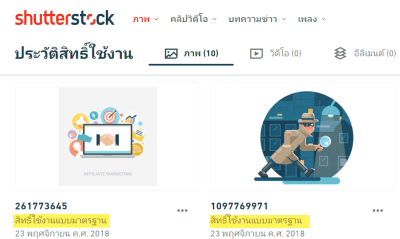Thinking about turning your video creations into a source of income? Shutterstock is one of the top platforms for stock videos, offering creators a chance to earn royalties whenever their clips are downloaded. But getting started can feel a bit overwhelming—what do you need to know to maximize your earnings? Don’t worry! In this guide, we’ll walk you through the essentials of uploading videos to Shutterstock and how to prepare your content for success. Whether you’re a seasoned videographer or just starting out, these tips will help you get noticed and boost your earnings.
Preparing Your Videos for Uploading

Before you hit that upload button, it’s crucial to make sure your videos are polished and meet Shutterstock’s quality standards. Proper preparation can make a big difference in how your videos perform and how much you can earn. Here’s a step-by-step guide to get your videos ready for prime time:
- Check the Technical Specifications: Make sure your videos are in the correct format (MP4 is preferred), with a resolution of at least 4K or Full HD (1920×1080). Use a high bitrate to ensure quality, and keep the file size manageable without sacrificing clarity.
- Ensure Proper Lighting and Clear Audio: Good lighting enhances visual appeal, and clear, crisp audio keeps viewers engaged. Remove background noise and consider adding subtitles if necessary.
- Limit Noise and Distractions: Trim out any unnecessary parts, shaky footage, or distracting backgrounds. Shutterstock prefers clean, professional-looking content.
- Color Correction and Grading: Enhance your footage with subtle color correction to make it vibrant and consistent. This helps your videos stand out in search results.
- Metadata and Keywords: Prepare relevant keywords and descriptions that accurately reflect your video content. Think about what buyers might search for—be specific and avoid spammy tags.
- File Naming: Use clear, descriptive filenames that relate directly to the content. This can help with organization and searchability.
Taking the time to properly prepare your videos not only helps you meet Shutterstock’s standards but also makes your content more appealing to buyers. Remember, high-quality, well-edited videos with accurate metadata are more likely to be downloaded and generate consistent earnings. So, invest a little extra effort upfront—your future self (and your wallet) will thank you!
Creating a Shutterstock Contributor Account

So, you’re ready to start earning from your videos on Shutterstock? The first step is setting up your contributor account. Don’t worry—it’s pretty straightforward, and I’ll walk you through it so you can get started as smoothly as possible.
To create your account, head over to the Shutterstock Contributor Portal. Click on the “Sign Up” button, and you’ll be prompted to fill in some basic information. Here’s what you’ll need:
- Full Name
- Email Address
- Password
- Country of Residence
- Tax Information (for earning and payout purposes)
Make sure to use an email address you check regularly, as Shutterstock will send important notifications and updates there. Once you submit your details, they’ll ask you to verify your email—just click the link in the confirmation email.
Next, you’ll need to provide some additional details to complete your profile. This includes:
- Profile picture (optional but recommended)
- Banking information for payouts
- Tax ID or Social Security number (for tax compliance, depending on your country)
Take your time filling out this information accurately—it’ll make the payout process smoother later on. After your profile is set up, you’re officially a Shutterstock contributor! Now, you can start uploading your videos and earning money.
Pro tip: Make sure to read Shutterstock’s contributor guidelines and terms of service to understand what types of content are accepted and how earnings are calculated. Being familiar with their rules will help you avoid any issues down the line and maximize your earning potential.
Uploading Your Videos to Shutterstock
Great! Your contributor account is ready, and now it’s time to upload your videos. Let’s go through the process step-by-step to ensure your videos are optimized for maximum earnings.
Step 1: Prepare Your Videos
Before uploading, double-check that your videos meet Shutterstock’s quality and content guidelines. Here are some quick tips:
- Resolution: At least 1920×1080 pixels (Full HD) or higher.
- Format: MP4 is preferred, using H.264 codec.
- Length: Typically, videos between 5 seconds and 60 minutes are accepted. Short, engaging clips tend to perform well.
- Quality: Ensure your videos are stable, well-lit, and free of watermarks or logos.
Additionally, consider adding a few sample clips to your portfolio that showcase your unique style or niche. Unique content tends to stand out and earn more.
Step 2: Log In and Access the Upload Panel
Once your videos are ready, log into your Shutterstock contributor account. From your dashboard, click on the “Upload” button. This will take you to the upload interface, which is user-friendly and guides you through the process.
Step 3: Upload Your Video Files
Drag and drop your video files into the upload window or select them manually from your device. You can upload multiple videos at once, which saves a lot of time if you’re batch uploading.
While your videos upload, you’ll be prompted to add metadata—details like titles, descriptions, and keywords. This part is crucial because it helps buyers find your videos easily, impacting your earnings significantly.
Step 4: Add Metadata and Tags
This is where you want to be strategic. Use relevant, descriptive keywords that match the content of your video. Think about what a buyer might search for—use synonyms and related terms. Write a clear, engaging title and a concise description. This will boost your chances of your videos appearing in search results.
| Metadata Element | Tips |
|---|---|
| Title | Be specific and include keywords naturally. |
| Description | Summarize the video content and include relevant details. |
| Keywords | Use 10-20 relevant tags, mixing broad and niche terms. |
After filling out metadata, review everything carefully. Mistakes or vague descriptions can hurt your video’s visibility and earnings.
Step 5: Submit for Review
Once all fields are complete, click “Submit.” Your videos will go through Shutterstock’s review process, which usually takes a few days. If your videos meet their quality standards and guidelines, they’ll be approved and go live in the marketplace.
And that’s it! With each approved video, you’re one step closer to earning passive income. Keep uploading consistently, optimize your metadata, and stay updated on Shutterstock’s trends and requirements to maximize your earnings over time.
Optimizing Video Metadata for Better Visibility
Alright, so you’ve uploaded your video to Shutterstock—congratulations! But wait, before you start dreaming about those royalty checks rolling in, there’s a crucial step you don’t want to overlook: optimizing your video’s metadata. Think of metadata as your video’s digital resume; it tells Shutterstock’s search engine what your video is about, helping it get discovered by buyers worldwide.
Why is metadata important? Well, even the most stunning video won’t get views if nobody can find it. Proper metadata ensures your video appears when someone searches for relevant keywords. It’s like giving your video a map that leads viewers right to it.
Crafting Effective Titles
Your title should be clear, descriptive, and include relevant keywords. Instead of vague titles like “Video 1,” try something specific like “Sunset over Mountain Lake at Dusk.” This helps buyers searching for specific scenes find your work easily.
Writing Detailed Descriptions
The description is your chance to add context and include additional keywords. Be honest and precise—describe what’s happening, the location, mood, and any other details that might help a buyer decide if it’s right for their project. For example:
- Location: Rocky Mountain National Park
- Scene: Vibrant sunset over a tranquil mountain lake
- Uses: Nature documentaries, travel promos, relaxation videos
Using Relevant Keywords
Keywords are the backbone of search visibility. Think about what terms buyers might search for. Use a mix of broad and specific keywords. For example:
| Broad Keywords | Specific Keywords |
|---|---|
| Nature | Sunset |
| Travel | Mountain lake |
| Relaxation | Peaceful scenery |
Remember, don’t overstuff keywords—keep them relevant and natural. Also, avoid using misleading tags; Shutterstock values accuracy and quality.
Additional Tips
- Keep metadata concise but informative.
- Use synonyms and related terms to widen your reach.
- Update metadata if you notice your videos aren’t getting enough views—sometimes tweaking titles or keywords can make a difference.
All in all, investing time in well-crafted metadata can significantly boost your video’s visibility and, ultimately, your earnings on Shutterstock. Think of it as planting seeds—you want to give your videos every chance to grow and reach the right audience.
Understanding Shutterstock’s Review Process
So, you’ve uploaded your masterpiece, but your journey isn’t over yet. Before your video hits the shelves, it has to go through Shutterstock’s review process. While it might seem a bit daunting, understanding how this process works can help you prepare better and speed things along.
What does the review process entail?
Once you upload a video, Shutterstock’s team or automated system (depending on the volume and type of content) reviews it to ensure it meets their quality and content standards. This review typically covers:
- Technical Quality: Is the video sharp, well-lit, and free of noise or glitches?
- Content Compliance: Does it adhere to Shutterstock’s content guidelines? For example, no copyrighted music, logos, or identifiable individuals without model releases.
- Legal Aspects: Are there any copyright issues or sensitive content?
How long does the review take?
In most cases, reviews are completed within 24-48 hours. However, during busy periods or if your video requires manual review, it might take a bit longer—up to a week. Patience is key! You’ll receive an email notification once your video has been approved or if it requires edits.
What happens if my video is rejected?
Don’t worry! Rejections aren’t the end of the world. Shutterstock usually provides feedback on why your video was rejected. Common reasons include:
- Technical issues like poor lighting or unstable footage
- Copyrighted content (music, logos, or recognizable brands) without proper permissions
- Content that doesn’t meet quality standards or violates their guidelines
Use this feedback as a learning opportunity. Fix the issues and resubmit. Sometimes, minor tweaks can turn a rejected video into a best-seller.
Tips to Improve Your Chances During Review
- Upload high-quality, well-edited videos.
- Ensure you have all necessary model and property releases if people or private property are visible.
- Follow Shutterstock’s content guidelines strictly—avoid controversial or sensitive topics unless properly cleared.
- Check your metadata for accuracy and completeness before submitting.
Understanding this review process helps demystify what’s happening behind the scenes. Remember, patience and attention to detail are your best friends here. Once approved, your video is ready to start earning—so keep creating, keep submitting, and stay tuned for those earnings to roll in!
Tips for Increasing Your Video Earnings on Shutterstock
So, you’re ready to boost your earnings on Shutterstock? That’s fantastic! Earning more from your videos isn’t just about uploading a bunch of clips—it’s about strategic, thoughtful actions that make your content stand out and appeal to buyers. Here are some tried-and-true tips to help you maximize your earnings:
Focus on Trending and Evergreen Topics
Keep an eye on what’s trending—whether it’s seasonal themes, popular industry topics, or viral moments. At the same time, evergreen content like business tips, nature scenes, or everyday life can generate steady income over time. Combining trending and evergreen topics ensures your portfolio stays relevant and profitable.
Optimize Your Metadata
Think of your metadata—titles, descriptions, and keywords—as the keys that unlock your videos for buyers searching for specific content. Use clear, descriptive titles and detailed descriptions. For keywords, include relevant and specific terms that potential buyers might use. Don’t overstuff keywords; instead, focus on accuracy and relevance to improve discoverability.
Create High-Quality, Versatile Clips
Quality matters. Use good lighting, steady shots, and clear audio whenever possible. Also, produce clips that are versatile—think wide shots, close-ups, and different angles. This way, your videos can fit a variety of projects, increasing their appeal and earning potential.
Consistent Upload Schedule
Uploading regularly keeps your portfolio fresh and signals to Shutterstock that you’re an active contributor. Over time, this can lead to increased visibility and more sales. Set a manageable schedule—whether it’s weekly or bi-weekly—and stick to it.
Engage with the Shutterstock Community
Participate in forums, read other creators’ tips, and stay updated on platform news. Networking can provide insights into what buyers want and help you adapt your content strategy accordingly.
Monitor Your Performance
Use Shutterstock’s analytics tools to see which videos perform best. Pay attention to views, downloads, and earnings. This data can guide you to create more of what sells and refine your approach.
Offer Unique or Niche Content
While popular topics are great, don’t shy away from niche markets. Unique content can attract specific buyers and reduce competition. If you have specialized skills or knowledge, leverage that to create distinctive clips that stand out.
Common Mistakes to Avoid When Uploading Videos
Even seasoned creators make mistakes—it’s part of the learning process! But avoiding common pitfalls can save you time and help you earn more. Here are some mistakes to watch out for:
Uploading Low-Quality or Poorly Edited Videos
Shutterstock is all about quality. Uploading videos with bad lighting, shaky footage, or poor audio can hurt your reputation and reduce sales. Always review your clips carefully before uploading, and consider investing in basic editing tools to enhance your videos.
Ignoring Metadata Optimization
Failing to include relevant and accurate titles, descriptions, and keywords can make your videos invisible to buyers. Take the time to craft thoughtful metadata—this is how your content gets discovered!
Uploading Irrelevant or Misleading Content
Only upload videos that genuinely match their titles and descriptions. Misleading content not only frustrates buyers but can also lead to rejections or account issues.
Uploading Too Many Similar Clips at Once
While consistency is good, flooding the platform with similar videos can be counterproductive. It may dilute your portfolio’s quality and make it harder for your best clips to stand out. Focus on quality over quantity.
Ignoring Platform Guidelines
Each stock platform has specific rules about content, model releases, and technical specs. Not adhering to these can lead to rejections or even account suspension. Always review Shutterstock’s submission guidelines carefully.
Neglecting to Update and Refresh Content
Old or outdated videos can become less appealing over time. Regularly review your portfolio, update metadata, and replace outdated clips to keep your collection fresh and relevant.
Overlooking the Importance of Niche Content
Trying to cover every possible topic without a focus can spread you too thin. Find your niche—whether it’s drone footage, business scenes, or nature shots—and build expertise there for better results.
By steering clear of these common mistakes and applying the tips above, you’ll be well on your way to increasing your earnings on Shutterstock. Remember, patience and continuous improvement are key. Happy uploading!
Monitoring Your Earnings and Performance
Once you’ve uploaded your videos to Shutterstock, the next step is to keep a close eye on how they’re performing and what kind of earnings they’re generating. Staying informed helps you understand what types of content resonate most with buyers and where you might want to focus your efforts moving forward.
Shutterstock provides a user-friendly dashboard where you can track your sales, earnings, and views. Here’s what you should pay attention to:
- Sales Data: See which videos are selling the most. Are certain themes or styles performing better? Use this insight to guide your future uploads.
- Download Trends: Monitor how often your videos are downloaded over different periods. Seasonal trends or current events can influence demand.
- Earnings Reports: Review your earnings reports regularly to spot patterns. This helps you set realistic income goals and measure your progress.
To maximize your earnings, consider experimenting with different types of videos based on your performance data. For example, if nature footage tends to sell well, you might want to create more of that style. Conversely, if certain categories aren’t performing, it could be time to refocus your efforts elsewhere.
Engagement metrics like views and saves also give you clues about what catches the eye of potential buyers. If a particular clip garners lots of views but no sales, it might be worth revisiting the quality or editing of that video.
Remember, consistency is key. Regularly uploading new content and monitoring your stats ensures you stay on top of trends and keep your portfolio fresh. Over time, this proactive approach can significantly boost your earnings and help you build a sustainable income stream on Shutterstock.
Conclusion and Final Tips for Success on Shutterstock
Congratulations! You’ve now got a solid understanding of how to upload videos to Shutterstock and maximize your earnings. To wrap things up, here are some final tips to keep you on the path to success:
- Consistently Upload Quality Content: The more high-quality videos you upload, the higher your chances of making sales. Aim for originality, good lighting, clear audio, and engaging content.
- Stay Updated with Trends: Keep an eye on industry trends and popular themes. This can give you ideas for content that’s in demand.
- Optimize Your Metadata: Use descriptive, keyword-rich titles, tags, and descriptions. This improves your videos’ visibility in searches and attracts more buyers.
- Engage with the Community: Participate in Shutterstock forums or social media groups. Sharing experiences and tips can provide valuable insights and motivation.
- Monitor and Adapt: Regularly review your performance data. Use this info to refine your content strategy, focusing on what works best and phasing out less successful videos.
- Be Patient and Persistent: Building a steady income on stock footage takes time. Keep uploading, learning, and improving your craft.
Remember, success on Shutterstock isn’t just about uploading videos — it’s about understanding your audience, optimizing your content, and staying committed. With dedication and a strategic approach, you can turn your passion for videography into a rewarding source of income. Good luck, and happy creating!


